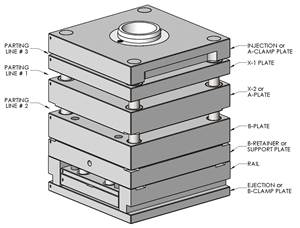CMM Investment Promotes Molder’s Growth
Processor Strategies: Yahagi America Molding
Adding new technology allows molder to expand into tighter-tolerance work.
An investment in new technology is paying off big at Yahagi America Molding Inc. (), Park City, Ky. This Tier 2 automotive molder recently added new metrology equipment and expects to nearly triple its revenues in the next few years because it can now process a wider range of tighter-tolerance parts.
“Based on our history of quality, pricing, and responsiveness, our largest customer wanted to expand the amount of ´óĎó´«Ă˝ we handled for them,” recalls Greg Parker, quality supervisor with YAMI. “However, growth would require technology upgrades and a mindset toward making some pretty big changes.”
YAMI first responded to the challenge by purchasing a coordinate measuring machine (CMM) from Mitutoyo America Corp., Aurora, Ill., as well as contour and surface-roughness measuring equipment from the same supplier. The new systems allowed YAMI to produce tighter-tolerance parts and measure and document quality-control requirements. Improved metrology capability also helped YAMI to reduce operating costs, get into molding abrasive materials and learn how to handle their detrimental effect on mold wear; and boost productivity and production scheduling—including job mix and lot sizes, says Parker.
YAMI now produces about 4 million parts a month, double the volume of just a few years ago. Mostly it molds lower-tolerance components for HVAC systems. Its 27 injection machines range from 18 to 280 tons. Annual sales are currently at $8 million, but YAMI’s target is $20 million within the next few years.
“It was quite a challenge to change both our mindset and overall capabilities to grow toward higher precision types of molding work,” states Parker. “When automotive companies started reducing their supplier bases, we made the cut. As a result, several precision part molding jobs were transferred to us.”
While the company could handle molding the parts, they didn’t have a way to check specifications to tighter levels and do so more quickly. Before, their only option was to use local outside metrology services to check tighter-tolerance parts. At times, YAMI used hand-held devices or a benchtop microscope. With a larger volume of work, they knew they had to bring metrology in-house for both precision and productivity.
Two important new jobs are an accelerator pedal/base assembly and an acceleration sensor used in airbag assemblies. These parts required tolerances of ±0.02 to ±0.05 mm. The sensor part is ultrasonically welded with a metal insert, resulting in a need to scan 50 points across the weld surface to make sure it meets flatness requirements.
Parker explains that the CMM measures quickly, accurately and cost-effectively. Mitutoyo’s Crysta-Apex CMM can measure the tighter tolerance levels and also can handle a higher volume of part checking. YAMI does 7 hr worth of checking the first and last parts of every run, including at least 24 airbag sensor parts and 12 accelerator bases/pedals each shift.
While most of YAMI’s parts could fit in the palm of your hand, the new CMM offers a much larger envelope. YAMI expects that future jobs might include larger part sizes, and the CMM could also allow checking the mold halves themselves for design, tryout, re-engineering, and repair work.
The airbag sensor part required specific QC checks not possible with YAMI’s previous equipment. For example, a 2-mm central radius is checked with Mitutoyo’s Contracer CV 3100 Profile Contour Measuring Machine. This ±0.2 mm tolerance check could not be measured by a radius gauge or other type of measuring device because of the intricate part design, states Parker. On that same part, a metal insert is checked to a 12 RZ roughness level with Mitutoyo’s Surftest SJ-400 Portable Surface Roughness Tester. The metal insert’s roughness level is critical because the part is ultrasonically welded in downstream operations and the overall surface must meet a precise roughness spec to provide a tight fit with a mating part.
Parker appreciates the user-friendliness that both machines provide, especially the color touchscreen interface and the high-speed printer that documents measurement results right at the workspace. Both machines provide a fairly small footprint that works well in their gauge room’s limited space.
Related Content
What to Look for in High-Speed Automation for Pipette Production
Automation is a must-have for molders of pipettes. Make sure your supplier provides assurances of throughput and output, manpower utilization, floor space consumption and payback period.
Read MoreUsing Data to Pinpoint Cosmetic Defect Causes in Injection Molded Parts
Taking a step back and identifying the root cause of a cosmetic flaw can help molders focus on what corrective actions need to be taken.
Read MoreHow to Design Three-Plate Molds, Part 1
There are many things to consider, and paying attention to the details can help avoid machine downtime and higher maintenance costs, and keep the customer happy.
Read MoreInjection Molding: Focus on these Seven Areas to Set a Preventive Maintenance Schedule
Performing fundamental maintenance inspections frequently assures press longevity and process stability. Here’s a checklist to help you stay on top of seven key systems.
Read MoreRead Next
Lead the Conversation, Change the Conversation
Coverage of single-use plastics can be both misleading and demoralizing. Here are 10 tips for changing the perception of the plastics industry at your company and in your community.
Read MoreSee Recyclers Close the Loop on Trade Show Production Scrap at NPE2024
A collaboration between show organizer PLASTICS, recycler CPR and size reduction experts WEIMA and Conair recovered and recycled all production scrap at NPE2024.
Read MoreMaking the Circular Economy a Reality
Driven by brand owner demands and new worldwide legislation, the entire supply chain is working toward the shift to circularity, with some evidence the circular economy has already begun.
Read More













